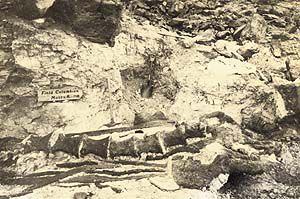| This postcard photo shows a Brachiosaurus fossil in-situ near the Colorado-Utah border. |
(Editors note: This is an interview with Jeff Bartlett, Director of Collections and Research at the College of Eastern Utah Prehistoric Museum. Teen View is a new column by Castle Valley secondary Students interviewing federal, state, county, local, and academic officials on public and state land, and rural land, recreational, natural resource, cultural and paleosntological resource, and community development use issues. Teen View also explores career opportunities and activities, “hands on”, relating to the column’s general topic for Castle Valley student’s participation.)
T V: Being home museum to the famous Utahraptor associated with the Steven Speilberg “Jurassic Park” movies, what new and exciting discoveries may you be announcing at the conclusion of this season’s field work?
Bartlett: Should the producers of “Jurassic Park Four” be looking for a new cinema player, the College of Eastern Utah Prehistoric Museum staff is going to announce the discovery of more “super nodosaur”. These are four-legged armored dinosaurs that weighed in excess of six tons. We have now uncovered the largest ever recorded and are studying just why they are so large.
TV: When we are in the desert or mountains with friends or family and discover a culture site, arrowhead, projectile point, pottery cherd, dinosaur bone, etc., on public or state lands, what should we do with our find?
Bartlett: The best thing to do is generally, nothing. Federal and state lands are off limits for the collection of most artifacts and dinosaur fossils. Data preserved in its natural state is priceless. However, if possible, please take pictures of your find, and a GPS reading is great Also a map on how to locate your discovery is also essential. We are very pleased to see more and more of this kind of record keeping occurring.
TV: What is the current status of the now famous prehistoric flute discovered at the Range Creek Wildlife Management Area?
Bartlett: As the flute was found on public land, we are still working with the Bureau of Land Management in the first steps of conserving this ancient object. We are currently under discussions with many agencies, and organizations, including the Hopi and other First Nations Tribes on the ways to do this. This is a cool example of the partnerships necessary for a sacred project of this nature working in harmony. The museum is often just the babysitter, not owner, of these valuable artifacts.
TV: Do natural resource and private development companies contact you, or other agencies, when they find fossils or artifacts during their work? Should they?
Bartlett: Yes. Over the past decade there have been more and more partnerships to help preserve priceless data and material.
TV: What activities will the museum be holding this fall and winter that high school students could participate in?
Bartlett: The College of Eastern Utah Prehistoric Museum will be holding two special holiday events that all students will enjoy and could volunteer for. We are having a fall volunteer drive to help with tours, floats, etc. There are always opportunities to help with field work during the season and in the bone lab during the winter. These are also great resume additions. The Utah Friends of Paleontology (UFOP) and Castle Valley Archaeology Society as well as cost-effective family memberships with the museum are all tremendous educational and hands-on opportunities for Castle Valley youth to help learn to respect and appreciate their spectacular world famous area.
TV: Are there possibly more world class archaeological and paleontological (fossil) discoveries awaiting in Castle Valley for high school students to help uncover?
Bartlett:Yes. With thousands of recorded Smithsonian numbered archaeological sites and over 70 world renowned dinosaur sites, Nine Mile Canyon, Range Creek Wildlife Management Area, the most important archaeological site in America in the past 50 years, this is the best place in the world for such discoveries. All of it is right here in Castle Valley our student’s virtual back yard. Just start attending UFOP, Castle Valley Archaeological Society, and CEU Prehistoric Museum meetings and functions and you can become an important part of it all.
TV: What steps could Castle Valley students presently take to prepare themselves for an exciting and rewarding career such as yours. Maybe even becoming a “toned down Indiana Jones?
Bartlett: This is not a painful process. Get all of the field experience you can through the free volunteer opportunities we have mentioned. There is currently a high demand for a career as field archaeologists. Take as many natural science, geology, energy, environmental, and other earth sciences courses you can in high school, and at CEU or USU or others that are available. All energy fields and all natural resource and federal and state resource fields are excellent career paths with jobs available presently. Go to the mountains and desert not just to play but to learn too.
(If you are an English teacher at Green River, Emery, or Carbon High Schools and have a student who would like to be considered for Teen View, please contact Craig Royce at Pinnacle High, 613-8102 or 888-2234 or e-mail countrymilescitymiles@hotmail.com.)

